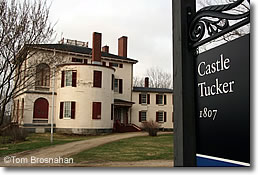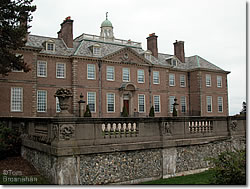Here's a list—though incomplete—of organizations dedicated to preserving the architectural, historic and natural treasures of Connecticut, Maine, Massachusetts, New Hampshire, Rhode Island and Vermont.
Historic New England (SPNEA)
Formerly the Society for the Preservation of New England Antiquities (SPNEA), Historic New England owns and maintains 32 historic houses, estates and farms in Connecticut, Maine, Massachusetts, New Hampshire and Rhode Island, including Beauport, the Sleeper-McCann mansion in Gloucester MA, and Castle Tucker in Wiscasset ME.

Castle Tucker in Wiscasset ME.
If you have any interest in domestic architecture, interior decoration and domestic life (particularly of the wealthy) in cities, towns and the countryside during the late 18th and 19th centuries in New England, you will want to visit several of Historic New England's properties.
National Trust for Historic Preservation
"The National Trust for Historic Preservation is a privately funded non-profit organization that provides leadership, education, advocacy, and resources to save America's diverse historic places and revitalize our communities."
Founded in 1949, the National Trust now cares for 26 historic sites throughout the USA, including four in New England: the African Meeting House and Abiel Smith School in Boston, Chesterwood in Stockbridge MA, Touro Synagogue in Newport RI, and Frank Lloyd Wright's Glass House in New Canaan CT.
The Trustees of Reservations
Founded in 1891, The Trustees is the oldest private non-profit conservation organization in the USA, dedicated to preserving natural open spaces in Massachusetts for the benefit of all.
The idea for a non-profit land conservation organization originated with Charles Eliot, a landscape architect working in Boston near the end of the 19th century.
In the 1880s, Eliot saw Boston's rapid industrialization and booming population threatening to engulf and destroy a priceless natural resource: open spaces with special features that made them particularly worthy of preservation.
Eliot wrote a letter to Garden and Forest, a Massachusetts periodical, and proposed the organization of a special non-profit corporation, headed by a board of volunteer trustees, to claim, hold title to, preserve, and make available to the public those special areas of land "just as a Public Library holds books and an Art Museum holds pictures."
A year later, the Massachusetts General Court voted to establish The Trustees of Reservations for this purpose.
The list of unique natural areas, houses and gardens, beaches and other properties preserved by The Trustees has grown long and rich. For details, and to support The Trustees' work, see The Trustees of Reservations website.
Emerald Necklace Conservancy
The great 19th-century American landscape architect Frederick Law Olmsted designed most of the famous city parks in the northeastern United States.
Among his greatest works were New York City's Central Park and the "Emerald Necklace" of parks, gardens and boulevards that extend natural beauty from Boston's historic Boston Common all through the city to the Arnold Arboretum miles away.
The Emerald Necklace Conservancy is dedicated to preserving and maintaining Olmsted's legacy, and enriching the experience of everyone who visits and enjoys this natural and architectural treasure.
The Conservancy organizes numerous fun events in the parks. Visit their website for details.

